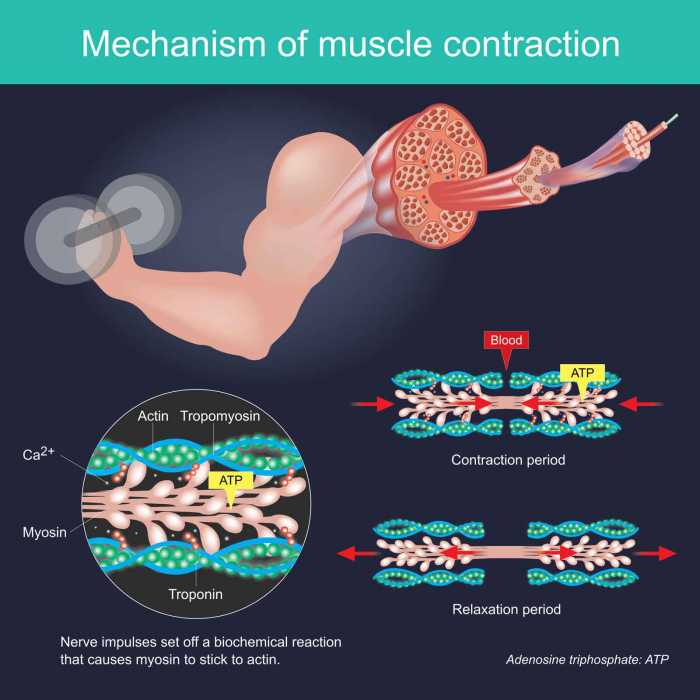What is a Muscle?
Online Glossary / Quick Reference
A contractile organ composed of muscle tissue, blood vessels, nerves, and connective tissues; skeletal muscle is associated with weight training.
About Muscle

A muscle is a contractile organ composed of muscle tissue, blood vessels, nerves, and connective tissues. Muscles are essential for movement, stability, and various bodily functions. Skeletal muscle, specifically, is associated with weight training and voluntary movements, distinguishing it from smooth muscle (found in internal organs) and cardiac muscle (found in the heart).
How Muscles Work
Muscles function through a process called contraction, which involves the interaction of specialized proteins within the muscle fibers. The primary proteins involved are actin and myosin, which form structures known as myofilaments. These myofilaments are organized into repeating units called sarcomeres, the basic functional units of a muscle fiber.
When the brain sends a signal via motor neurons to a muscle, it triggers the release of calcium ions within the muscle fibers. These calcium ions bind to regulatory proteins on the actin filaments, exposing binding sites for myosin. The myosin heads then attach to the actin filaments, forming cross-bridges. Using energy from ATP (adenosine triphosphate), the myosin heads pull the actin filaments toward the center of the sarcomere, shortening the muscle fiber and producing contraction.
This contraction process is known as the sliding filament theory, where actin and myosin filaments slide past each other to shorten the muscle. When the stimulation from the motor neuron ends, calcium ions are pumped back into storage within the muscle fiber, the binding sites on actin are covered again, and the muscle relaxes.
Components of Muscle
- Muscle Tissue: The primary component, consisting of muscle fibers (or cells) that contract to produce movement.
- Blood Vessels: Supply oxygen and nutrients to the muscle tissue and remove metabolic waste products.
- Nerves: Control muscle contractions by transmitting signals from the brain and spinal cord.
- Connective Tissues: Include tendons (which attach muscles to bones), fascia (which surrounds muscles), and ligaments (which connect bones to other bones).
Types of Muscle
- Skeletal Muscle: Attached to bones and responsible for voluntary movements, posture, and stability. Skeletal muscles are striated and can be consciously controlled.
- Smooth Muscle: Found in the walls of internal organs (such as the stomach, intestines, and blood vessels) and responsible for involuntary movements like peristalsis and vasoconstriction.
- Cardiac Muscle: Makes up the heart's walls and is responsible for pumping blood throughout the body. Cardiac muscle is striated like skeletal muscle but functions involuntarily.
Functions of Skeletal Muscle
- Movement: Skeletal muscles contract to produce voluntary movements, allowing for activities like walking, running, lifting, and throwing.
- Stability: Muscles help maintain posture and stabilize joints, providing support for the skeleton.
- Heat Production: Muscle contractions generate heat, helping to regulate body temperature.
- Metabolic Functions: Skeletal muscles store glycogen and can metabolize glucose and fatty acids for energy, playing a role in overall metabolism.
Muscle Adaptation to Training
- Hypertrophy: With consistent resistance training, muscles increase in size (hypertrophy) due to the growth of individual muscle fibers.
- Strength Gains: Muscles adapt to increased loads by becoming stronger, allowing for improved performance in weight training and other physical activities.
- Endurance Improvement: Endurance training enhances the muscle's ability to sustain prolonged activity by improving mitochondrial density and capillary networks.
Common Muscle-Related Terms
- Muscle Fiber: The individual cells that make up muscle tissue, capable of contracting and generating force.
- Myofibril: The rod-like structures within muscle fibers containing the contractile proteins actin and myosin.
- Sarcomere: The basic functional unit of a muscle fiber, responsible for muscle contraction.
- Neuromuscular Junction: The synapse where a motor neuron communicates with a muscle fiber to initiate contraction.


